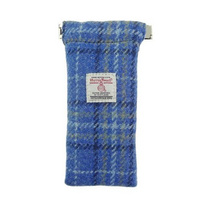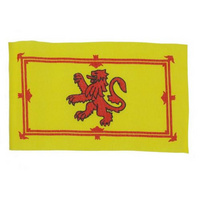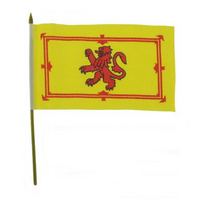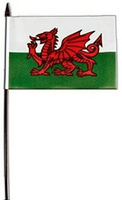Flags of the world
Home » Scottish Gifts » Flags of the world
If your flag is not here then contact us and we will include it in our next order. Flags are imported from Stewarton, Scotland.
Harris Tweed Glasses Case in Light Blue Check |
LB2109-COL129 |

Harris Tweed Soft Glasses Case with spring clip - 18cm x 9cm.
|
|
| Full Details | add to cart NZ$49.50 |
Lion Rampant Flag - 60x36 |
FP1642 |

Lion Rampant Flag - 60 x 36 inches.
|
|
| Full Details | add to cart NZ$18.00 |
Lion Rampant Flag with Stick - 9x6 |
FP1639 |

Lion Rampant Flag with Stick - 9 x 6 inches.
|
|
| Full Details | add to cart NZ$3.80 |
Wales Hand Waving Flag |
Flag small Wales |

Hand waving Flag on a black stick.
Flag measures 6" x 9" |
|
| Full Details | add to cart NZ$3.80 |
Afghanistan |
Flag 21 |

The current flag was adopted by the Islamic Republic of Afghanistan in 2004. This flag is similar to the one flown in Afghanistan during the monarchy between 1930 and 1973. The difference is the addition of the shahadah at the top of the coat of arms (seen in yellow) in the centre. This flag consists of three stripes of the colours black, red, and green. This has been present on most flags of Afghanistan in the last twenty years. The centre emblem is the classical emblem of Afghanistan with a mosque with its mihrab facing Makah.
|
|
| Full Details | add to cart NZ$18.00 |
Argentina National flag |
Flag 11 |

National flag of Argentina. 100% polyester 1500mm x 900mm. Suitable for flagpole.
A triband flag with horizontal bands coloured light blue, white and light blue with the yellow Sun of May charged in the center. The flag was created by Manuel Belgrano, in line with the recent creation of the Cockade of Argentina, and was first raised at the city of Rosario on February 27, 1812, during the Argentine War of Independence. |
|
| Full Details | add to cart NZ$18.00 |
Austria |
Flag 24 |

National flag of Australia. 100% polyester, suitable for a flagpole. 1500mm x 900mm.
The flag of Austria has three equal horizontal bands of red (top), white, and red. The Austrian triband is based on the coat of arms of the Babenberg dynasty, recorded in the 13th century. It may have seen use in flags from about the 15th century, alongside the black-and-yellow colours of the House of Habsburg and other insignia of the Holy Roman Empire. It was adopted as a naval ensign in the 18th century, and as national flag in 1918. |
|
| Full Details | add to cart NZ$18.00 |
Australia National flag |
Flag 09 |

National flag of Australia. 100% polyester, suitable for a flagpole. 1500mm x 900mm.
For many years there was considerable misunderstanding in Australia and in other countries with regard to the use of the Australian flags. During World War II, Prime Minister Menzies issued a directive that there should be no restriction on the flying of the "Commonwealth Blue Ensign", and Prime Minister Chifley gave his support to that view in 1947. In 1953, by means of a Commonwealth Act of Parliament – the Flags Act 1953 – the "British Blue Ensign" was proclaimed the national flag. Only since then has it had seniority over the Union Jack. |
|
| Full Details | add to cart NZ$18.00 |
Brazil |
Flag 26 |

National flag of Brazil. 100% polyester, suitable for a flagpole. 1500mm x 900mm.
The national flag of Brazil (Portuguese: Bandeira do Brasil) is a blue disc depicting a starry sky spanned by a curved band inscribed with the national motto, within a yellow rhombus, on a green field. Brazil officially adopted this design for its national flag on November 19, 1889, replacing the flag of the Empire of Brazil. |
|
| Full Details | add to cart NZ$18.00 |
China |
Flag 50 |

The flag of China was officially adopted on 1 October 1949. The red of the Chinese flag symbolizes the communist revolution, and it's also the traditional color of the people. The large gold star represents communism, while the four smaller stars represent the social classes of the people.
|
|
| Full Details | add to cart NZ$18.00 |
Colombia |
Flag 25 |

National flag of Colombia. 100% polyester, suitable for a flagpole. 1500mm x 900mm.
The horizontal stripes (from top to bottom) of yellow, blue and red tricolour have a ratio of 2:1:1. It—together with that of Ecuador, also derived from the flag of Gran Colombia—is different from most other tricolour flags, either vertical or horizontal, in having stripes which are not equal in size. Yellow: represents all the gold found in the Colombian land. Blue: represents the seas on Colombia's shores. Red: represents the blood spilled for Colombia's independence. |
|
| Full Details | add to cart NZ$18.00 |
St George Cross, England |
Flag 13 |

Flag of England. St George Cross. 100% polyester 1500mm x 900mm suitable for a flagpole.
The Flag of England is the St George's Cross (heraldic blazon: Argent, a cross gules). The red cross appeared as an emblem of England in the Middle Ages. It also represents the official arms of the Most Noble Order of the Garter, and it achieved status as the national flag of England during the 16th century |
|
| Full Details | add to cart NZ$18.00 |
Wales |
Flag 04 |

National Flag of Wales. 1500mm x 900mm. 100% polyester, suitable for a flagpole.
The flag of Wales (Welsh: Baner Cymru or Y Ddraig Goch, meaning "The Red Dragon") consists of a red dragon passant on a green and white field. As with many heraldic charges, the exact representation of the dragon is not standardised and many renderings exist. The flag incorporates the Red Dragon of Cadwaladr, King of Gwynedd, along with the Tudor colours of green and white. It was used by Henry VII at the Battle of Bosworth Field in 1485 after which it was carried in state to St Paul's Cathedral. The red dragon was then included as a supporter of the Tudor royal arms to signify their Welsh descent. It was officially recognised as the Welsh national flag in 1959. |
|
| Full Details | add to cart NZ$18.00 |
France |
Flag 15 |

National flag of France. 100% polyester suitable for a flagpole. 1500m x 900mm.
The national flag of France is a tricolour featuring three vertical bands coloured royal blue (hoist side), white, and red. It is known to English speakers as the French Tricolour or simply the Tricolour. The royal government used many flags, the best known being a blue shield and yellow fleur-de-lis on a white background, or state flag. Early in the French Revolution, the Paris militia, which played a prominent role in the storming of the Bastille, wore a cockade of blue and red, the city's traditional colours. According to Lafayette, white, the "ancient French colour", was added to the militia cockade to create a tricolour, or national, cockade. This cockade became part of the uniform of the National Guard, which succeeded the militia and was commanded by Lafayette. The colours and design of the cockade are the basis of the Tricolour flag, adopted in 1790. A modified design by Jacques-Louis David was adopted in 1794. |
|
| Full Details | add to cart NZ$18.00 |
Ghana |
Flag 27 |

National flag of Ghana. 100% polyester, suitable for a flagpole. 1500mm x 900mm.
The flag of Ghana was designed and adopted in 1957 and was flown until 1962, and then reinstated in 1966. It consists of the Pan-African colours of red, yellow, and green, in horizontal stripes, with a black five-pointed star in the centre of the gold stripe. The Ghanaian flag was the second African flag after the flag of Ethiopia to feature these colours. The black star was adopted from the flag of the Black Star Line, a shipping line incorporated by Marcus Garvey that operated from 1919 to 1922 and gives the Ghana national football team their nickname, the Black Stars. The flag was designed by Theodosia Okoh. The red represents the blood of those who died in the country's struggle for independence from the United Kingdom, the gold represents the mineral wealth of the country, the green symbolises the country's rich forests and natural wealth, and the black star is the symbol of African emancipation. |
|
| Full Details | add to cart NZ$18.00 |
Honduras |
Flag 28 |

National flag of Honduras. 100% polyester, suitable for a flagpole. 1500mm x 900mm.
This national flag of Honduras was adopted on 7 March 1866, based on the flag of the Federal Republic of Central America. In 1823 Honduras joined the United Provinces of Central America and adopted their flag. In 1866 it was amended; five cerulean stars were placed in the centre to represent the five original Central American provinces. The colours and pattern are the same as the flag of the United Provinces of Central America. The flag consists of three horizontal bands of equal width with an overall length:width ratio of 2:1. The two outer cerulean bands represent the Pacific Ocean and the Caribbean Sea and also represent the blue sky and brotherhood. The inner white band represents the land between the ocean and the sea, the peace and prosperity of its people, and purity of thoughts. The five cerulean five-pointed stars arranged in an X pattern centered in the white band represent the five nations of the former Federal Republic of Central America (El Salvador, Costa Rica, Nicaragua, Honduras, and Guatemala) and the hope that the nations may form a union again. |
|
| Full Details | add to cart NZ$18.00 |
Hungary |
Flag 29 |

The flag of Hungary (Hungarian: Magyarország zászlaja) is a horizontal tricolour of red, white and green. In this exact form, it has been the official flag of Hungary since 1 October 1957. The flag's form originates from national republican movements of the 18th–19th century, while its colours are from the Middle Ages.
|
|
| Full Details | add to cart NZ$18.00 |
Korea DPR |
Flag 30 |

The flag was adopted when the northern portion of Korea became a socialist republic supported by the People's Republic of China and the Soviet Union following the restoration of independence of Korea in 1945. The flag itself was designed and promulgated by Kim Tu-bong and formally replaced the taegukgi in July 1948. The new flag was called People's Republic flag.
A 270-kg (600lb) North Korean national flag flies from the world's third tallest flagpole, which is located at Kijŏng-dong, on the North Korean side of the Military Demarcation Line within the Korean Demilitarized Zone. The flag-pole is 160 meters (520 feet) tall. There are several other known flags in use. There are flags for the Korean People's Army, and its two subdivisions the Korean People's Air Force and Korean People's Navy, which follow a common design but with different colours (blue and white for the Navy and dark blue and light blue for the Air Force). There is also a flag of the ruling Worker's Party of Korea, modelled after similar communist party flags, and a flag for the Supreme Commander of the KPA used by Kim Jong-un, which has the Supreme Commander's Arms on a red field. |
|
| Full Details | add to cart NZ$18.00 |
Mali national flag |
Flag 23 |

The flag of Mali (French: Drapeau du Mali) is a tricolour with three equal vertical stripes. From the hoist (the place where the flagpole meets the flag) the colours are green, gold, and red, the pan-African colours. The flag is almost identical to the flag of Guinea, with the exception that the colours are in reverse order.
The flags colours have different meanings. The green stands for fertility of the land, Gold means purity and mineral wealth and lastly red symbolizes the blood shed for independence from the French. The current flag was adopted on 1 March 1961 |
|
| Full Details | add to cart NZ$18.00 |
Panama |
Flag 33 |

The flag of Panama was made by María de la Ossa de Amador and was officially adopted by the "ley 48 de 1925". The Panamanian flag day is celebrated on November 4, one day after Panamanian independence from Colombia.
The first flag proposed in 1903 consisted of 7 horizontal stripes of red and yellow, with a blue canton containing 2 golden suns, joined by a narrow line to depict the oceans to be united by the Panama Canal (see the depiction below). However, this was not accepted by the Panamanian leader, Manuel Amador Guerrero, whose family designed a new flag. The stars and quarters are said to stand for the rival political parties, and the white for the peace in which they operate. Blue was the colour of the Conservatives, and red the colour of the Liberals.[2] |
|
| Full Details | add to cart NZ$18.00 |
Portugal |
Flag 35 |

The flag of Portugal is the national flag of the Portuguese Republic. It is a rectangular bicolour with a field unevenly divided into green on the hoist, and red on the fly. On 30 June 1911, less than a year after the downfall of the constitutional monarchy, this design was officially adopted for the new national flag, after selection by a special commission whose members included Columbano Bordalo Pinheiro, João Chagas and Abel Botelho.
The conjugation of the new field colours, especially the use of green, was not traditional in the Portuguese national flag's composition and represented a radical republican-inspired change that broke the bond with the former religious monarchical flag. Since a failed republican insurrection on 31 January 1891, red and green had been established as the colours of the Portuguese Republican Party and its associated movements, whose political prominence kept growing until it reached a culmination period following the Republican revolution of 5 October 1910. In the ensuing decades, these colours were popularly propagandized as representing the hope of the nation (green) and the blood (red) of those who died defending it, as a means to endow them with a more patriotic and dignified, therefore less political, sentiment. |
|
| Full Details | add to cart NZ$18.00 |
Qatar |
Flag 36 |

The flag of Qatar is in the ratio of 11:28. It is maroon with a broad white serrated band (nine white points) on the hoist side. It was adopted shortly before the country's declaration of independence from Britain on 3 September 1971.
The flag is very similar to the flag of the neighbouring country Bahrain, which has fewer points, a 3:5 proportion, and a red colour instead of maroon. Qatar's flag is the only national flag having a width more than twice its height. |
|
| Full Details | add to cart NZ$18.00 |
Senegal |
Flag 37 |

The flag of Senegal is a tricolour consisting of three vertical green, yellow and red bands charged with a five-pointed green star at the centre. Adopted in 1960 to replace the flag of the Mali Federation, it has been the flag of the Republic of Senegal since the country gained independence that year. The present and previous flags were inspired by French Tricolour, which flew over Senegal until 1960
|
|
| Full Details | add to cart NZ$18.00 |
Serbia |
Flag 38 |

|
|
| Full Details | add to cart NZ$18.00 |
South Africa |
Flag 08 |

South African flag. 1500mm x 900mm. 100% polyester, suitable for a flagpole.
The current flag of the Republic of South Africa was adopted on 27 April 1994, at the beginning of the 1994 general election, to replace the flag that had been used since 1928. The new national flag, designed by State Herald Frederick Brownell, was chosen to represent the new democracy. Three of the colours — black, green and yellow — are found in the flag of the African National Congress. The other three — red, white and blue — are used in the old Flag of Transvaal, the modern flag of the Netherlands and the flag of the United Kingdom; the colours white and blue were also found in the old flag of South Africa. Former South African President F.W. de Klerk, who proclaimed the new flag on 20 April 1994,[1] stated in his autobiography, The Last Trek: a New Beginning, that chilli red was chosen instead of plain red (which Anglo-Africans would have preferred) or orange (as Afrikaners would have preferred). |
|
| Full Details | add to cart NZ$18.00 |
